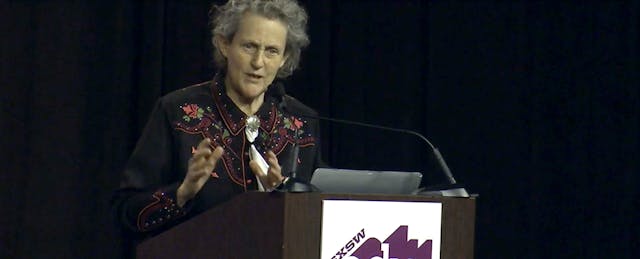As autism diagnoses increase, so too do the number of parents and teachers battling its effects in children. On SXSWedu’s main stage, in front of bright lights and teachers who struggle to teach autistic children the “ordinary” lessons of school, opening keynote speaker Dr. Temple Grandin shined as an autistic woman who has achieved extraordinary things.
Or, as she put it bluntly herself, “I think I’m doing pretty well for someone who, when I was a little kid, people thought was mentally retarded.”
Her keynote argued that every learner’s brain is wired differently, and educators should focus on students’ strengths, rather than labeling their deficiencies.
Dr. Grandin is well known as an advocate for animal rights and for people with autism. She was born in 1947 and, when diagnosed with autism three years later, her parents were told that Temple should be put into an institution. Young Temple did not speak until she was three-and-a-half years old, and spent much of her school years secluding herself from peers. However, with early intervention by therapists and support from her family and mentors, Dr. Grandin thrived in the study of livestock. After school she enjoyed a highly successful career designing improved and more humane farm slaughter equipment, and now serves as a Professor of Livestock Behavior & Welfare at Colorado State University.
On stage at the Austin Convention Center, Dr. Grandin showed none of the reclusiveness that marked her childhood. Upon taking the podium, she called, to the delight of the standing-room-only audience: “One of the things we’ve got to be doing is to keep Austin weird!”.
Once the cheering settled, Dr. Grandin outlined the four types of learners, as well as the weaknesses of each. She described herself as an “object visualizer” whose mind processes thoughts by associating images together. Her brain, she says, is well suited to highly visual work such as designing a new slaughter pen, but struggles with verbal tasks and non-visual subjects like algebra.
She lamented how educators sometimes simply label students as “autistic” or “ADHD” when, in reality, the student’s strengths don’t match the types of learning offered in the classroom. Labeling also encourages conflict, she noted, offering the example of the enmity between “field people” and “academics.” Once someone is labeled as belonging to one category, others will make assumptions about their goals and behaviors, leading to a deterioration of the relationship.
Dr. Grandin shared her own experience to explain how focusing on a student’s strengths can lead them to success. Although her speech was delayed as a child, her family encouraged her artistic talents. “I think in pictures, and I used to think that everybody else thought in pictures too,” she recounted. “Being a visual thinker helped me with my work on livestock; animals notice small details.” It was this attention to detail that led her to develop the improved slaughtering mechanisms for which she is famous.
To combat a focus on students’ weaknesses, Dr. Grandin argued for additional time spent on hands on—though not necessarily physical—activities: “You’ve got to touch to perceive.” As an example, she suggested pairing SketchUp, an online 3D drawing program, with a 3D printer in order to combine tech-based and hands-on learning.
The idea that there’s a “learning style” that best fits a student has been under fire. Recent reports have argued that tailoring instruction to learning styles does not measurably improve learning outcomes in students. Additionally, the proliferation of potential learning styles and corresponding instructional strategies may be confusing to both educators and students. Worse, it can be co-opted by companies who see it as a way to market their tools.
Grandin didn’t suggest any direct connection between learning styles to explicit academic outcomes. Her point was that, when used effectively, these preferences can help teachers and parents find the right ways to engage kids in educational activities.
Dr. Grandin also advocated for exposing students to as many subjects as possible in school. This variety lets each student find the subjects, and possible career paths, most interesting to them. She related how she never would have found her present career if her mother hadn’t gotten her a job on a ranch one summer, “I was exposed to the cattle industry; Bill Gates was exposed to programming. It’s important to expose kids to different subjects.”
Though the themes she covered may have been familiar to much of the audience, the keynote was well-received. As Dr. Grandin ended the session, the room rose in unison for a standing ovation. Her appeal is the ability to see the potential that lies behind the challenges faced by many autistic students—and to call on teachers to give every student the opportunity to find joy in learning. “Half of Silicon Valley is a little on the autism spectrum,” she claims. “A little bit of autism gives you a very smart guy.”
Watch the full Keynote here:


